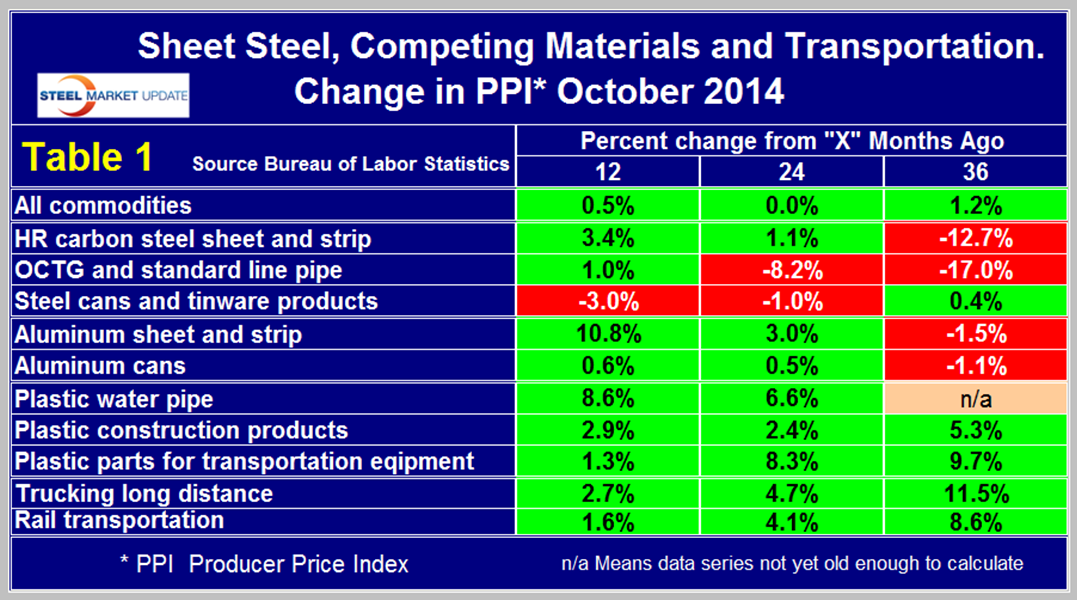Economy

Producer Price Indexes of Sheet Steel, Aluminum, Plastic and Transportation - October 2014
Written by Peter Wright
November 19, 2014
Each month the Bureau of Labor Statistics, (BLS) puts out its series of producer price indexes, for thousands of goods and materials. The latest release on Tuesday reported October results. We run this analysis every three months to give readers an opportunity to become aware of any changes in the competitive position of steel against other materials and rail vs truck transportation. See below for the official description of this program.
![]() The October report from the BLS began as follows: The Producer Price Index for final demand rose 0.2 percent in October, seasonally adjusted, the U.S. Bureau of Labor Statistics reported today. This increase followed a 0.1-percent decline in September and no change in August. On an unadjusted basis, the index for final demand advanced 1.5 percent for the 12 months ended in October, the smallest 12-month increase since a 1.2-percent rise in February 2014. In October, the 0.2-percent rise in final demand prices can be traced to the index for final demand services, which advanced 0.5 percent. In contrast, prices for final demand goods moved down 0.4 percent. Within intermediate demand, prices for processed goods declined 0.9 percent, the index for unprocessed goods fell 2.4 percent, and prices for services inched up 0.1 percent.
The October report from the BLS began as follows: The Producer Price Index for final demand rose 0.2 percent in October, seasonally adjusted, the U.S. Bureau of Labor Statistics reported today. This increase followed a 0.1-percent decline in September and no change in August. On an unadjusted basis, the index for final demand advanced 1.5 percent for the 12 months ended in October, the smallest 12-month increase since a 1.2-percent rise in February 2014. In October, the 0.2-percent rise in final demand prices can be traced to the index for final demand services, which advanced 0.5 percent. In contrast, prices for final demand goods moved down 0.4 percent. Within intermediate demand, prices for processed goods declined 0.9 percent, the index for unprocessed goods fell 2.4 percent, and prices for services inched up 0.1 percent.
For the purpose of this report, SMU has extracted comparative statistics for sheet steel, aluminum and plastic products and truck and rail transportation. Table 1 is a summary of each category on a year over one, two and three year basis. One cell in this table for plastic water pipe contains the code n/a because this data series is too new to make a 36 month comparison.
Our analysis of the PPI data shows that the acceleration in commodity prices slowed to 0.5 percent in 12months through October from 1.3 percent in 12 months through September. In fact commodity prices were back to where they were two years ago. A rising $ will put downward pressure on commodity prices but evidently the demand side of the equation is over-riding currency effects at this time. Of particular interest in this analysis is the huge surge in the PPI of aluminum sheet and strip. We speculate that one driver of this increase could be the anticipation of future demand from the Ford F150 program. Plastic water pipe has also surged in the last twelve months but we expect this will go into reverse when the current oil price percolates through the supply chain. On November 14th the International Energy Agency reported, “A rout in oil prices is likely to continue into the first half of 2015 unless global output is reduced. Crude prices have fallen around 30 percent since June to hover near four-year lows amid sluggish demand growth and a surplus of oil supply as a result of booming production in North America. Though the IEA expects demand growth to pick up throughout next year after falling to its weakest level in five years in 2014, it forecasts demand will fall steeply at the start of 2015 compared to the end of this year. Meanwhile, robust oil supply shows no sign of abating.
Steel cans have improved their competitive position against aluminum cans by 3.6 percent in the last twelve months.
The PPI data are helpful in monitoring the price direction of steel and steel products against competing materials and products. As far as we at SMU can tell from comparison with known transaction prices, these PPI are a good representation of the real world. However our observation is that the actual values of the PPIs of different products cannot be compared with one another because they are developed by different committees within the BLS. We believe that this data is useful only in comparing the direction of prices in the short and medium term.
Table 1 also shows price changes for truck and rail transportation and indicates that highway delivery has lost ground to rail in the last 12, 24 and 36 month periods.
The official description from the Bureau of Labor Statistics, (BLS) reads as follows. The Producer Price Index (PPI) is a family of indexes that measure the average change over time in the prices received by domestic producers of goods and services. PPIs measure price change from the perspective of the seller. This contrasts with other measures, such as the Consumer Price Index (CPI). CPIs measure price change from the purchaser’s perspective. Sellers’ and purchasers’ prices can differ due to government subsidies, sales and excise taxes, and distribution costs. More than 9,000 PPIs for individual products and groups of products are released each month. PPIs are available for the products of virtually every industry in the mining and manufacturing sectors of the U.S. economy. New PPIs are gradually being introduced for the products of industries in the construction, trade, finance, and services sectors of the economy. More than 100,000 price quotations per month are organized into three sets of PPIs: (1) Stage-of-processing indexes, (2) commodity indexes, and (3) indexes for the net output of industries and their products. The stage-of processing structure organizes products by class of buyer and degree of fabrication. The commodity structure organizes products by similarity of end use or material composition. The entire output of various industries is sampled to derive price indexes for the net output of industries and their products.
Product Detail: Over 80 percent of the October decline in prices for final demand goods can be attributed to the index for gasoline, which dropped 5.8 percent. Prices for liquefied petroleum gas, prepared animal feeds, home heating oil, diesel fuel, and ethanol also moved lower. In contrast, the index for meats increased 5.3 percent. Prices for electric power, pharmaceutical preparations, and passenger cars also advanced. (In accordance with usual practice, most new-model-year passenger cars and light motor trucks were introduced into the PPI in October. See Report on Quality Changes for 2015 Model Vehicles here.)

Peter Wright
Read more from Peter WrightLatest in Economy

Chicago PMI dips 0.1 points in June
The Chicago Purchasing Managers Index (PMI) slipped 0.1 points to 40.4 points, in June.

Multi-family pullback drives housing starts to 5-year low in May
US housing starts tumbled in May to a five-year low, according to figures recently released by the US Census Bureau.

Architecture firms still struggling, ABI data shows
Architecture firms reported a modest improvement in billings through May, yet business conditions remained soft, according to the latest Architecture Billings Index (ABI) release from the American Institute of Architects (AIA) and Deltek.

Manufacturing in New York state contracts again
However, companies are growing more optimistic about the future.

ArcelorMittal plans wire-drawing closure in Hamilton, shifts production to Montreal
ArcelorMittal’s (AM) Hamilton location to be shuttered, wire production shifting to Montreal.

